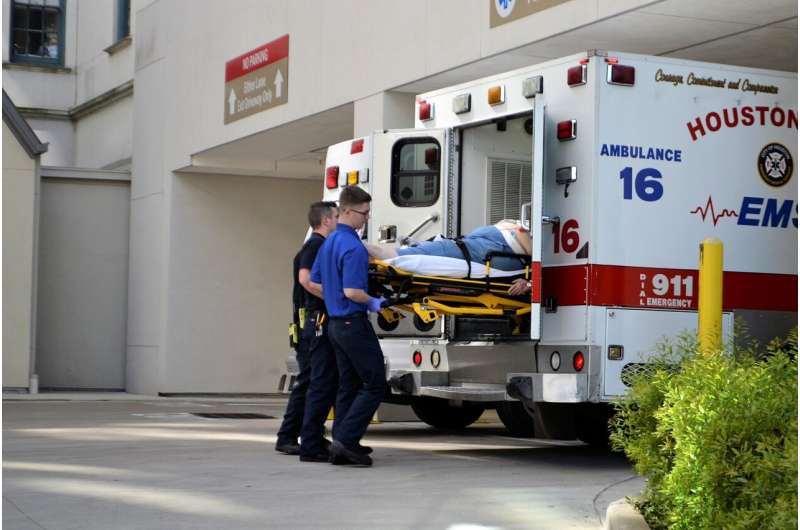

Cardiac rehabilitation enrollment rose among adults with heart failure with reduced ejection fraction after Medicare started covering it in 2014, yet overall enrollment among Medicare beneficiaries remains very low—less than 10% of those eligible according to preliminary research to be presented at the American Heart Association’s Quality of Care and Outcomes Research Scientific Sessions 2021.
Heart failure occurs when the heart isn’t pumping as well as it should to deliver oxygen- and nutrient-rich blood to cells and organs throughout the body. Heart failure with reduced ejection fraction means the ejection fraction, or how much blood the left ventricle pumps with each contraction, is at or below 40%. Normal ejection fraction is considered 50% to 70%.
According to the American Heart Association’s Heart Disease and Stroke Statistical Update 2021, more than 6 million American adults have heart failure. Heart failure prevalence is projected to increase by 46% from 2012 to 2030, affecting more than 8 million people 18 years of age and older.
“There are nearly 1.1 million hospitalizations for heart failure annually, making it one of the most common reasons for hospital admission among people 65 years of age or older, whose health care costs are primarily covered by Medicare,” said study author Vinay Guduguntla, M.D., a third-year internal medicine resident at the University of California, San Francisco. “Despite recent advancements in treatment, long-term survival after hospitalization is poor for adults with heart failure. Overall, more than 70% of adults with heart failure are re-hospitalized or die within one year after discharge. In addition, most experience declining exercise capacity and reductions in daily living activities and quality of life.”
There is strong evidence that a supervised exercise regimen, like the physical activity plan integrated into cardiac rehab programs, can prevent death, reduce hospitalization and improve physical function in adults with heart failure. However, less than 3% of eligible patients had enrolled in cardiac rehab prior to 2014, when the U.S. Centers for Medicare and Medicaid Services (CMS) expanded coverage of cardiac rehab to include people with stable, chronic heart failure with reduced ejection fraction.
To determine what, if any, benefit the expanded Medicare reimbursement had among patients with heart failure with reduced ejection fraction, researchers analyzed a sample of Medicare claims data from 2008 to 2017, prior to and after the 2014 CMS ruling. They identified 849,054 Medicare fee-for-service beneficiaries, 65 years of age and older, who had heart failure with reduced ejection fraction. The analysis found:
- Nearly 34,200 people (about 4% of the population studied) attended cardiac rehabilitation during the study period.
- Analysis of the time period prior to the Medicare reimbursement change, from 2008 to 2014, found that cardiac rehabilitation use increased slowly, from 3.30% to 4.30%, about a 5% relative increase year-to-year.
- After the 2014 Medicare expansion to cover cardiac rehab for people with heart failure with reduced ejection fraction, rates of cardiac enrollment went from 4.30% in 2014 to 5.54% in 2017, with a relative increase of about 10% year-to-year.
- Overall, although the absolute enrollment rate in cardiac rehabilitation remained low, expanding Medicare coverage in 2014 was associated with a notable increase in the use of cardiac rehab among adults with heart failure.
“Despite clear benefits of cardiac rehabilitation in preventing death, reducing hospitalizations and improving physical ability, cardiac rehabilitation is used by very few. Based on the current data, more than 90% of people with heart failure will not receive a treatment that could improve their health and survival,” Guduguntla said. “Our study highlights insurance coverage as one important factor that impacts increasing cardiac rehabilitation participation. Future work should aim to identify and address all barriers to enrollment and find creative solutions to this complex problem.”
“Enacting public policies is one effective way to address the enrollment barriers that prevent the majority of people with heart failure from benefitting from cardiac rehabilitation,” said Randal J. Thomas, M.D., a past chair of the American Heart Association’s Council on Clinical Cardiology and professor of medicine in the Mayo Clinic Cardiac Rehabilitation Program in Rochester, Minnesota, who was not involved in the study. “Additional congressional funding is needed to support the federal Million Hearts Initiative which is doing important work to improve access to and participation in cardiac rehabilitation through measures such as increasing physician referrals, promoting transportation services and advancing telehealth support. In addition, lawmakers should support legislation such as the bipartisan ‘Increasing Access to Quality Cardiac Rehabilitation Care Act’. This legislation would expand cardiac rehabilitation resources by accelerating the timetable for enabling physician assistants, nurse practitioners and clinical nurse specialists to order and supervise cardiac rehabilitation.”
Thomas noted CMS participation criteria is also a significant barrier to cardiac rehabilitation for people with heart failure. “CMS criteria requires that patients wait at least 6 weeks after a heart failure hospitalization to participate in cardiac rehabilitation,” he said. “Studies show that any delay in starting cardiac rehabilitation after hospitalization decreases participation rates and worsens patient outcomes.”
A limitation of the study is the lack of information about cardiac rehabilitation by location, race/ethnicity and other demographic factors about individuals. Guduguntla said this information is important to fully understand why the use of cardiac rehab is so low.
Source: Read Full Article